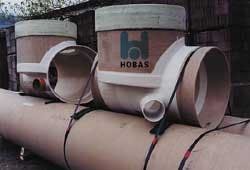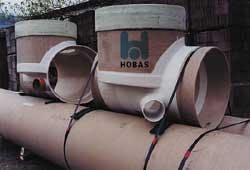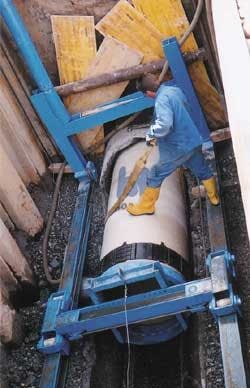Relined interceptor sewer withstands corrosive wastewater
By Barbara Osinger
A relined pipe system in Frastanz, Austria, fulfils all requirements of a stand-alone pipe without the high cost and disruption of new pipeline installation.
HOBAS CC-GRP Pipe Systems relined nearly three kilometres of a seriously damaged 23-years-old reinforced concrete pipeline in Frastanz, Austria, with centrifugally cast glass fiber reinforced polyester (CC-GRP) pipe systems. Damage from corrosive industrial wastewater created static insecurities in the interceptor sewer pipeline. The new pipe system of PN 2.5 and SN 5000 now fulfils all static requirements of a new stand-alone pipeline. HOBAS AG is based in Basel, Switzerland and its operational headquarters are located in Klagenfurt, Austria.
Planners needed pipes with a high chemical resistance to aggressive substances in industrial wastewater to guarantee a long service life. HOBAS Pipe Systems made of CC-GRP fulfil these requirements: The polyester resins encase the two other components of the pipe material so that only the resin comes into contact with the aggressive media, thus ensuring high corrosion resistance. Furthermore, the smoothness (k-value of 0.01 including the spigot) of the pipe wall ensures an optimum flow rate, despite the reduced pipe diameter.
The Austrian consortium of contractors Rabmer of Alternberg near Linz and Rhomberg of Bregenz relined 2.9 km of interceptor sewer pipeline within four months for the client Abwasserverband Region Feldkirch, the regional government agency responsible for wastewater pipeline systems. The planning was assured by the engineering office M + G Ingenieure of Feldkirch.
Installation
The starting pits for inserting the pipe system were approximately 8-m-long by 2-m-width and the depth up to the lower edge of the old pipe. This specification enabled easy insertion of the pipes with the standard length of 6 m. Shorter pipes can be supplied if necessary. These assembly pits were arranged at the bending points of the old pipeline or the shaft areas.
The contractor detoured the wastewater from the sections to be rehabilitated, setting this pipeline section out of operation. The old pipe in each starting pit was cut open lengthways and used as insertion guidance for the new pipeline.
Unnecessary shafts without bending points could be driven through, shafts with bending points were replaced by smaller HOBAS shafts or rehabilitated with HOBAS GRP. Prefabricated shafts were coupled on site, others were adapted or laminated on site.
Before putting the pipe into the relining device, the contractor mounted polyethylene (PE) on the pipe ends (respectively some centimetres before) in order to avoid damaging the external pipe wall while inserting them, assure a safe position and minimise the effect of floating when grouting.
The single pipes were connected in the starting shaft. The pipes were inserted into the host pipe section by section. The enlarging new pipeline was pushed ahead one pipe length after the other by a hydraulic device.
The annular space was filled for many reasons. It allows fixing the pipeline in the old line. It avoids penetration of water and soil while ensuring defined bedding, and thus enables an even transfer of outside loads. Furthermore, the filling prevents a collapse of the defective sewer, it secures the pipeline against floating and it helps balance slight temperature-dependent length variations. A special material was used for the controlled filling process. All involved parties were satisfied with the relining project and use of the HOBAS CC-GRP pipe system. The first months of operation showed excellent results.
Author's note
Barbara Osinger works for Hobas Engineering, based in Basel, Switzerland. For more information, visit www.hobas.com


